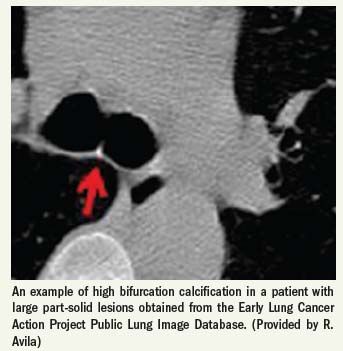Combined pulmonary assessments produce lung cancer biomarker
Researchers have found a potential new imaging biomarker for lung cancer.
Researchers have found a potential new imaging biomarker for lung cancer. By combining data gleaned from thin-slice CT scans at the tracheal bifurcation with results of spirometry they have developed a lung cancer risk index. Spirometry, which measures forced expiratory volume in 1 sec over forced vital capacity, assesses lung function.
Toxic exposure to carcinogenic particulate matter can lead to lung cancer. When such particulate matter is deposited in the bronchial aspects of the lung and in the alveoli, the damage it causes is expressed in terms of emphysema and loss of lung function. What is less well known is that the bifurcation as the airways enter the lungs gets hit with up to 100 times more toxic exposure than other parts of the lung, according to Ricardo S. Avila, lead investigator of the study and senior director of healthcare solutions at Kitware, a software company. The study was published in the July issue of Academic Radiology.
“Rather than thinking of the lung as a relatively flat landscape, where risk is equal everywhere, I started to think, if [airway] bifurcations are getting hit hard, why not look at [them] in high-resolution CT and determine whether there are any changes there,” Avila said.
He found that some lung cancer patients tended to have greater amounts of calcification in their bifurcations. But because not every lung cancer patient did, he looked at pulmonary function as well. When pulmonary function was plotted against the calcification score, a trend emerged indicating who was likely to get lung cancer and who was not.
Using the two metrics and the calcification index, Avila and his team found a 67% sensitivity and 72% specificity (Acad Radiol 2010;17:830-840).

“Some people could argue those numbers are not great. But remember, they represent our ability to detect lung cancer without any information other than those two metrics,” he said.
Avila included in the study 108 patients selected from a CT screening study, including 15 with early lung cancer, and 93 age-matched, pack-year-matched controls. CT scan slice thickness was either 1 mm or 1.25 mm.
The bifurcations are relatively small and the thicker the measurement, the more air will average into your data capture to disrupt it, he said.
“We saw a huge difference between individuals who were scanned with 1-mm CTs versus ones scanned with 1.25-mm,” he said.
The data are still in the early stages of being analyzed, but looking at calcifications at bifurcations certainly could be a new imaging biomarker, said Dr. Claudia Henschke, a radiology professor at Mt. Sinai Medical Center in New York City and lead investigator of the International Early Lung Cancer Action Project.
“Further work and further validation are needed on it,” she said. “It’s an excellent idea; it needs to be pursued.”
The data make sense in a practical way because whatever a person is inhaling includes not only gases but particulates, said Dr. David Yankelevitz, also a professor of radiology at Mt. Sinai. And, as they go down the airways they bump into the bifurcations.
“In that regard it makes sense this is the first area that would be sensitive,” he said.
Avila has a small database but what he’s researching shows a lot of promise and is worth pursuing, Yankelevitz said.
“I think at some point this will be a marker that’s available for any patient who has a CT scan of the chest,” he said. “But you don’t want to start getting people too excited when you don’t know the full meaning yet.”
Calcification at bifurcations isn’t something that’s been considered before but the information has always been there.
“That’s what’s neat,” Yankelevitz said. “Avila is trying to pick out a pattern that we haven’t focused on. At least for now he’s seeing some relationship. It could be very useful.”
GE HealthCare Debuts AI-Powered Cardiac CT Device at ACC Conference
April 1st 2025Featuring enhanced low-dose image quality with motion-free images, the Revolution Vibe CT system reportedly facilitates improved diagnostic clarity for patients with conditions ranging from in-stent restenosis to atrial fibrillation.
The Reading Room Podcast: Current Perspectives on the Updated Appropriate Use Criteria for Brain PET
March 18th 2025In a new podcast, Satoshi Minoshima, M.D., Ph.D., and James Williams, Ph.D., share their insights on the recently updated appropriate use criteria for amyloid PET and tau PET in patients with mild cognitive impairment.